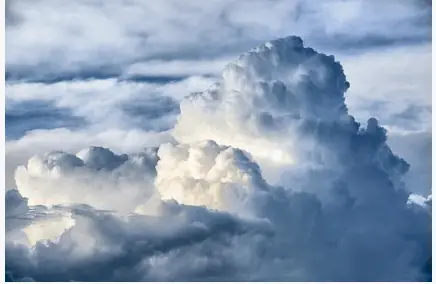Activity of text interpretation, aimed at students in the seventh year of elementary school, about drawings of water in the sky. What drawings the author of the text refers to, huh? Are you curious? So, read the text carefully! Then answer the various interpretative questions proposed!
This reading comprehension activity is available for download in an editable Word template, ready to print to PDF, as well as the completed activity.
Download this text interpretation exercise at:
SCHOOL: DATE:
PROF: CLASS:
NAME:
Read:
Our planet is surrounded by various gases, which we call the atmosphere. The heat radiated by the sun reaches the surface of planet Earth, causing the water to evaporate, from the seas, rivers, lakes and forests: as the hot air – this steam – is lighter, it rises to the atmosphere. The cloud is formed by transforming steam into tiny water droplets or ice crystals. Therefore, there are more clouds on hot days, which favors increased evaporation.
When the steam rises to the atmosphere, it finds the air at a lower temperature, which causes ______ the steam to turn into a droplet liquid, or even freeze, when the temperature is too low, creating ice crystals, and starting the process of formation of clouds. If this vapor condensation occurs near the ground, mists form.
As we like to observe, clouds can be positioned in different places in the sky, with different shapes and sizes. The temperature, the height of the cloud and the intensity of the light received influence these different aspects and cloud formations, as well as the presence and distribution of impurities in the atmosphere, which attract water vapors, such as industrial vapors, dust etc.
Regarding the appearance of clouds, there are more than ten different types, according to the amount of particles of water and the distribution in the sky, with three main forms: Cumulus (bands, like parts of cotton, white and fluffy); Stratus (uniform, layered, like a sheet), covering the sky; and Cirrus (as brushed lines).
Daniele Souza. Available in:. (Fragment).

Question 1 - In “Drawings of water in the sky”, what does the author of the text refer to?
A:
Question 2 - Identify the purpose of the text:
( ) alert.
( ) report.
( ) explain.
Question 3 - According to the text, “[…] there are more clouds on hot days, which favor an increase in evaporation”. Point out the cause of this fact:
( ) "Our planet is surrounded by various gases, which we call the atmosphere."
( ) “The heat radiated by the sun reaches the surface of planet Earth […]”
( ) "The cloud is formed through the transformation of steam into small droplets of water [...]"
Question 4 – Reread this text fragment:
“[…] finds the air at a lower temperature, which makes ______ the steam turn into a liquid drop […]”
The space must be filled with:
( ) "in"
( ) "with".
( ) "for".
Question 5 - In the part “[…] creating ice crystals, and starting the process of cloud formation.”, the word “e” indicates:
( ) facts that add up.
( ) alternating facts.
( ) contrasting facts.
Question 6 – In the passage "if this vapor condensation occurs close to the ground, mists are formed.”, the underlined term expresses:
( ) a hypothesis.
( ) a condition.
( ) a concession.
Question 7 – In the segment “[…] attract water vapors, such as industrial vapors, dust etc.”, the word “how” was used to:
( ) indicate examples.
( ) make a comparison.
( ) introduce a conclusion.
Question 8 – The passage “[…] uniform, in layers, like a sheet […]” describes:
( ) “Cumulus”.
( ) “Stratus”.
( ) “Cirrus”.
By Denyse Lage Fonseca
Graduated in Languages and specialist in distance education.
 report this ad
report this ad